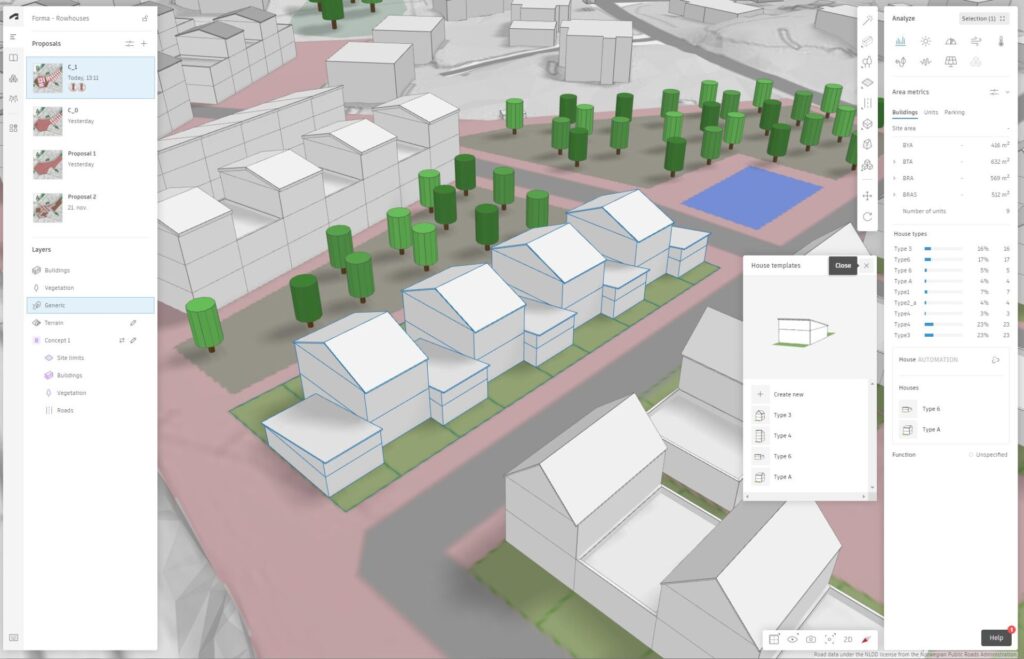When I heard that we were building a “Row house”-tool in Forma, my mind went a lot of places. I was both excited about the prospect of a parametrical tool to populate sites and a little worried we would digitize and empower industrial-scale urban sprawl at the click of a button.
How can we enable architects and planners to explore low-density typologies efficiently and effectively? And why would we develop a tool for row houses specifically?
“Remember, with great power comes great responsibility.”
Uncle Ben

Turns out that naming new features is hard. After much discussion between industry experts, architects, beta testers, and product developers, we landed on simply naming it the “House”-tool.
This tool allows you to design modules of townhouses, single-family detached houses, semi-detached houses, row houses, or terraced houses and marks an interesting start to new parametric building tooling in Autodesk Forma.
But before we nerd out about what this tool symbolizes for the future, let’s talk about what is available now and, more importantly, how to use it to its full effect. I recently sat down with Arne Bjelland, architect and product manager at Autodesk Forma, and Ragnhild Milter, senior UX designer, to discuss the tool in our recent webinar “Get Going with Forma Go Further with Forma: Housing tools,” you can catch the full recording here if you’re interested.
How to design townhouses, duplexes, and other low-density housing types in Forma
With our flexible housing feature, you can swiftly populate your site with various housing types and quickly iterate on your design. This feature accommodates low-density housing developments such as row houses, single housing, and duplexes.
You will find the House drawing tool in the same category in the design toolbar as Line buildings and Basic buildings: it can be accessed by clicking the Buildings icon.

You can either place multiple houses along a line, such as along a street or place houses individually for more granular control. And of course, you can rotate and set the orientation and snap parcels together.
Refining your typology
All is as expected so far. What I find interesting is what happens when you start manipulating the type of house you would like to place on-site. By defining a parcel larger than a house’s footprint, you start to build detached housing, but you can then control where on your parcel you would like to place your houses, creating semi-detached houses.
Take this to the extremes, and you could parametrically produce porta-potties or garages using the same tool, it really is versatile!
More impressively, from a tool perspective, is that the number of each type of house you have defined will be accounted for in the area metrics tab. And the tool can of course be used alongside all the other design tools that Forma enables, natively or through extensions.
So, in one fell swoop you have the tools you’d need to execute on a “high-low” strategy, where an urban plot should accommodate many types of homes and families, from small rental apartments to family row houses and two-bedroom owned apartments. A common strategy in my own Nordic market. I know many of you architects have had projects like this; I, for one, spent most of my early career developing these kinds of projects.
You can read all about the tool’s capabilities in the comprehensive help article here!
What’s the right approach to low-density housing?
How do you do it right, though? That’s the million-dollar question! How can we build sustainable, well-thought-out neighborhoods where people want to live? When we talk about low-density housing in Autodesk Forma, an early-stage planning and design tool, we do not discuss how to document and build houses; for that, you already have Revit or AutoCAD.
What we need to be thinking about is how to design better cities and neighborhoods that include these attractive typologies. Because the stats are not lying, the row house offers an appealing compromise between urban density and the feeling of a private house in many markets.
But only if done right.
Common amongst the academia on this is the drive for community, nature, connections, and sustainable urban density. If you build too dense too rural, your project will be rejected by buyers in favor of larger parcels with bigger houses, and if you build too urban and your project site costs may spiral to a point where even more density is required, and who wants to live on the first floor looking into the concrete wall of a high-rise anyway?
It’s a delicate balancing act between building dense enough and urban enough yet maintaining the qualities that make this typology attractive. At least, that’s my perspective on it.
But I’m no Jørn Utzon, so instead, to remind us how to do neighborhoods right, I’ve invited a few guest writers to the blog over the coming months to talk about how to design low-density typology and neighborhoods right. I look forward to learning more together with you.